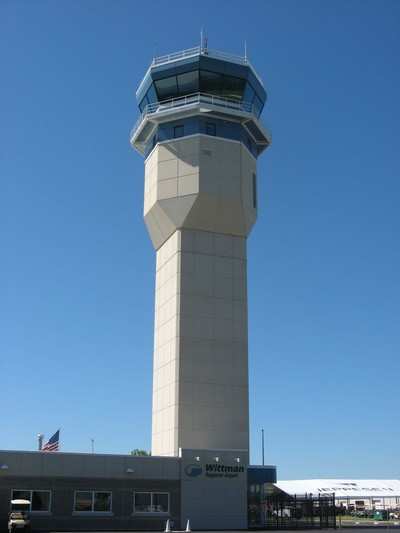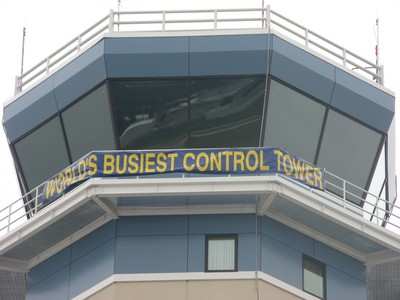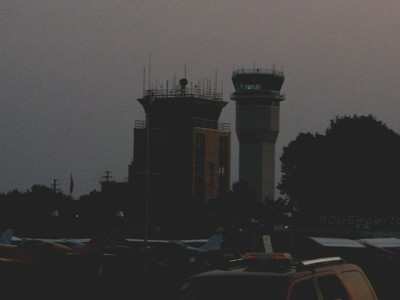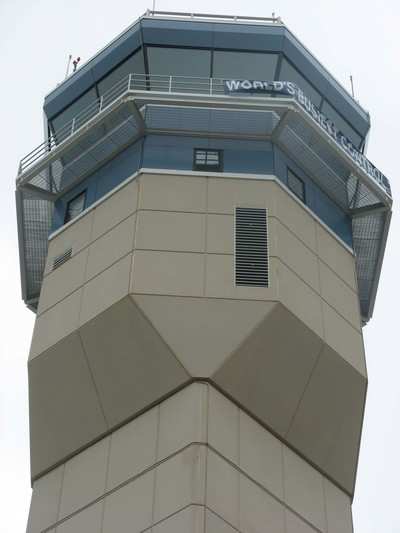New Control Facility Gets A Shakedown At AirVenture
'08
by ANN Correspondent Dave Slosson
As you enter the grounds of Wittman Regional Airport this year,
you'll see a new sight from almost anywhere on the grounds. The new
control tower is up and operational!

Originally funded in late 2003 to be 120 feet tall and cost $4
million in state money, the design, physical location, height of
the tower and size of the base building all changed. To accommodate
the AirVenture controller numbers, functions, and needs, the base
building was enlarged. To improve the sightlines of the
controllers, the location was changed and the tower was made
another 20 feet taller.
All the changes delayed the building process such that
construction finally was started in the spring of 2007 and
completed in mid-May of 2008 at a cost of between $6.4M and $7
million. Finishing the installation and testing of the equipment
took the other month and a half before operations were commenced on
July 1.
Building a control tower is a complicated undertaking. Siting
was done through computer simulation at the FAA Technical Center in
Atlantic City, NJ. This optimized the placement of the tower on the
field, taking into account all the existing and future placement of
runway, taxiways, trees, buildings and roads. This ensured the
tower was tall enough without being too tall, as the Tech Center
staff can literally put a tower anywhere on the field they want and
show you a view from any height.

The staff runs simulated traffic to your runways while you look
out the windows of your future tower. It is the epitome of airport
sims.
So with the tower site and height established, the architect
designed and built it to suit the site. Omnni Associates of
Appleton, WI designed this tower. Then the general contractor was
hired from bids, and they subcontracted the electrical, mechanical,
and construction jobs that develop the site. The general contractor
for Oshkosh tower was Miron Construction Company of Neenah, WI.
Overseeing the building process were FAA engineers, who protect
the building codes of the federal government and make sure the
contractors build things according to plan. Once the equipment
started to arrive for the controllers, another contractor was
involved in the placement and installation. Racks of equipment were
installed in the equipment room and cables run up the tower shaft
to the controller positions in the tower cab.

A working group, usually consisting of a management
representative from the FAA, and the union representative from
NATCA, representing the controllers, decides placement in the cab.
Since a union does not represent the Oshkosh contract controllers,
the tower manager worked with the FAA and sought input from the
controllers.
Once all the equipment was installed, testing began. Oshkosh
tower is not a 24-hour facility, so most of the testing was done at
night during closure hours. This minimized the impact to the
operation. Cutover, the changing of operations from the old tower
to the new, was also accomplished by ending operations in the old
cab on the night of June 30, and beginning operations July 1 in the
new facility. The Tech Ops personnel and the FAA and contract
personnel changed cable connections and threw switches during the
night to make sure the morning operation would be seamless. In the
haste to make the move before this year's AirVenture, there are
still some equipment moves to be made. The phone lines and
landlines still ring in both the old and new towers.
The transmitters and receivers are still located in the old
tower and are being activated by the new voice switch via a long
underground cable. Since the two towers are only about 500' apart,
this is not a problem or a safety issue in any way. Once AirVenture
is over, the cutover will be completed; the new tower will be
totally isolated, and the old tower will be demolished. Glitches
that have been encountered post-move are minor, such as phone lines
ringing in the wrong location, or some grounding issues on the
voice switch. While annoying, they are not safety issues and are
dealt with on a case-by-case basis. Most of today's air traffic
equipment is run by computers and is pretty complex, but any
problem is also easily resolved as the software helps troubleshoot
the issue.

But let's look at what the city of Oshkosh and EAA AirVenture
gain from this new state-of-the-art tower. The controllers' views
are now 65' higher and unobstructed so they can see every taxiway,
every ramp and every approach to the runways. This adds a great
deal of safety to the operation. The new tower cab is 525 square
feet, compared to the old brick tower that had 325 square feet.
If you were ever lucky enough to get a tour of the tower while
the controllers were working AirVenture, you saw how crowded the
conditions were up there. Generally, there are at least 10
controllers working the positions, two supervisors or managers
overseeing the operation and coordinating with the teams on the
field and at Fisk, and a few other controllers hanging out on
break. Now add in the tour groups and news media and you get the
picture.
The old tower also had serious ventilation problems and poor
traffic flow through the cab. The new tower has more airflow with
its own heating and cooling unit for the tower cab and level below.
The stairs don't come up in the middle of the south local
controller group, like they did in the old tower, so there's
another enhancement to the operation. The placement of the
supervisor's position also helps the people flow in the cab.
Operationally, each position now has 4 jacks for the
controllers, allowing each of the local control teams to be plugged
into and monitoring all the radio transmissions simultaneously. It
also gives each local control team flexibility as to where they
want to stand to run their operation. South local can stand at the
south side of the cab for running Runway 36 operations, or on the
east side of the cab for Runway 18 operations. Similarly, north
local can stand at either the northeast corner for Runway 27 or on
the north side for Runway 9 operations. For IFR coordination with
Milwaukee approach control, they now have a STARS monitor to see
where the IFR arrivals are anywhere on the approach. In previous
years, they had to bring in a monitor and tie it to the center's
radar to have an idea where the traffic was located, but the
traffic was lost on radar as they descended on the approach. This
is an enhancement that will benefit the airport and its users
year-round.

In the new base building of roughly 6000 square feet, there is a
large training room, large enough to hold 25 people. This is where
the controllers and EAA flight line operations people will have
their pre- and post-shift safety briefings every day of AirVenture.
I'm sure a good use of this space can be found the other 51 weeks
of the year, such as training new controllers for Oshkosh tower,
holding pilot/controller meetings, or letting Tech Ops people
spread out their plans when they need to do so. There is an office
for the Technical Operations group, which has 3 technicians
assigned full-time to Oshkosh and one temporary tech that comes
down from Green Bay on occasion. They work in the new equipment
room, generator room, and boiler room for the day-to-day
operations. The controllers and Tech Ops personnel share a break
room with a kitchen. The manager's office for AirVenture is also in
the base building and will be used the other 51 weeks for storage
of AirVenture related equipment, such as the radio belts the
controllers wear when working the MOOCOWs. An administrative office
is used mostly for AirVenture, but can be utilized by the Oshkosh
staff during the rest of the year as well. Apparently, as I have
observed in other new towers being built in the last couple years,
storage availability is at a premium, with no dedicated storage
rooms being built. Equipment backups, printer paper, and all the
necessary pieces and parts that have to be stored to maintain all
the equipment and the building gets stuffed into any available
corner, shelf, or storage cabinet one can find.
So this year, when you tell someone you'll meet them at the
tower at a particular time, be sure to tell them which tower, the
old or the new. If it's the new, there's a large security fence
surrounding the tower, so you may want to specify a corner or side
of the compound. Regardless, it's a beautiful new landmark and a
great safety enhancement to Wittman Regional Airport and especially
AirVenture. Enjoy the show!
Our thanks to Wanda Adelman, Milwaukee tower manager and Oshkosh
tower manager during AirVenture, and Paul Drobnik, Tech Ops
technician, for contributing to this article.
 ANN's Daily Aero-Linx (04.16.24)
ANN's Daily Aero-Linx (04.16.24) Aero-News: Quote of the Day (04.16.24)
Aero-News: Quote of the Day (04.16.24) Airborne 04.10.24: SnF24!, A50 Heritage Reveal, HeliCycle!, Montaer MC-01
Airborne 04.10.24: SnF24!, A50 Heritage Reveal, HeliCycle!, Montaer MC-01 Airborne 04.12.24: SnF24!, G100UL Is Here, Holy Micro, Plane Tags
Airborne 04.12.24: SnF24!, G100UL Is Here, Holy Micro, Plane Tags Airborne-Flight Training 04.17.24: Feds Need Controllers, Spirit Delay, Redbird
Airborne-Flight Training 04.17.24: Feds Need Controllers, Spirit Delay, Redbird







